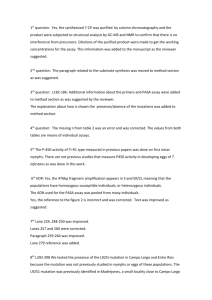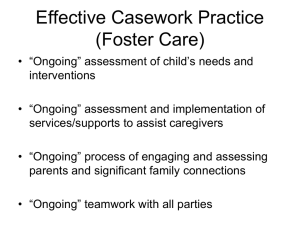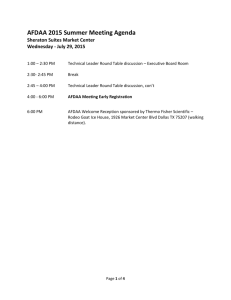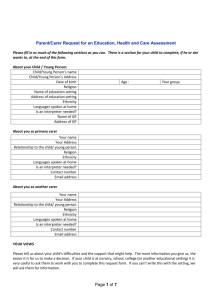Microsoft Word
advertisement
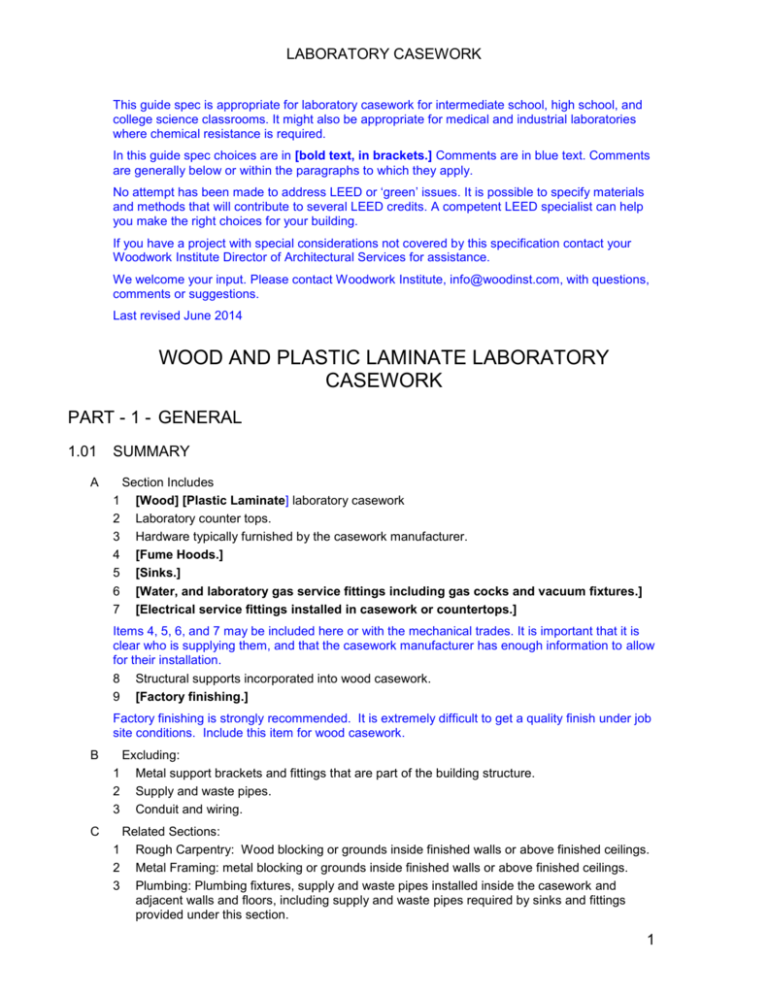
LABORATORY CASEWORK This guide spec is appropriate for laboratory casework for intermediate school, high school, and college science classrooms. It might also be appropriate for medical and industrial laboratories where chemical resistance is required. In this guide spec choices are in [bold text, in brackets.] Comments are in blue text. Comments are generally below or within the paragraphs to which they apply. No attempt has been made to address LEED or ‘green’ issues. It is possible to specify materials and methods that will contribute to several LEED credits. A competent LEED specialist can help you make the right choices for your building. If you have a project with special considerations not covered by this specification contact your Woodwork Institute Director of Architectural Services for assistance. We welcome your input. Please contact Woodwork Institute, info@woodinst.com, with questions, comments or suggestions. Last revised June 2014 WOOD AND PLASTIC LAMINATE LABORATORY CASEWORK PART - 1 - GENERAL 1.01 A SUMMARY Section Includes 1 [Wood] [Plastic Laminate] laboratory casework 2 Laboratory counter tops. 3 Hardware typically furnished by the casework manufacturer. 4 [Fume Hoods.] 5 [Sinks.] 6 [Water, and laboratory gas service fittings including gas cocks and vacuum fixtures.] 7 [Electrical service fittings installed in casework or countertops.] Items 4, 5, 6, and 7 may be included here or with the mechanical trades. It is important that it is clear who is supplying them, and that the casework manufacturer has enough information to allow for their installation. 8 Structural supports incorporated into wood casework. 9 [Factory finishing.] Factory finishing is strongly recommended. It is extremely difficult to get a quality finish under job site conditions. Include this item for wood casework. B 1 2 3 C Excluding: Metal support brackets and fittings that are part of the building structure. Supply and waste pipes. Conduit and wiring. Related Sections: 1 Rough Carpentry: Wood blocking or grounds inside finished walls or above finished ceilings. 2 Metal Framing: metal blocking or grounds inside finished walls or above finished ceilings. 3 Plumbing: Plumbing fixtures, supply and waste pipes installed inside the casework and adjacent walls and floors, including supply and waste pipes required by sinks and fittings provided under this section. 1 LABORATORY CASEWORK 4 Electrical: [Electrical fixtures and equipment installed in casework or on countertops and their wiring and conduit.] [Wiring and conduit to electrical fixtures and equipment included in this section.] If electric fixtures and equipment are included in this section use the second option. If they are included in another section use the first option. 5 [Laboratory Equipment.] Delete #5 if all lab equipment is included in this section. 6 HVAC: Ducting to fume hoods. 1.02 REFERENCES A “Architectural Woodwork Standards” (AWS), latest edition, published by the Architectural Woodwork Institute, the Architectural Woodwork Manufacturer’s Association of Canada, and the Woodwork Institute. B SEFA 1 (Fume Hoods), latest edition, published by the Scientific Equipment and Furniture Association. C SEFA 3 (Work Surfaces), latest edition, published by the Scientific Equipment and Furniture Association. D SEFA 7, (Laboratory and Hospital Fixtures), latest edition, published by the Scientific Equipment and Furniture Association. E SEFA 8 W, (Wood Casework), latest edition, published by the Scientific Equipment and Furniture Association. F SEFA 8 PL (Plastic Laminate Casework) latest edition, published by the Scientific Equipment and Furniture Association. 1.03 A SUBMITTALS Shop Drawings: 1 Submit shop drawings in conformance with the requirements of the AWS. 2 [Furnish a Woodwork Institute Certified Compliance Shop Drawing Label on the first page of the shop drawings.] Include this item if you are using the Woodwork Institute Certified Compliance or Monitored Compliance quality assurance programs. 3 Submit two copies, one of which will be returned with reviewed notations. Make corrections noted (if any) and distribute required copies prior to the start of work. B [Documentation: Include this if chemical resistance is a requirement. 1 Submit test data showing countertop materials performance subjected to a [sixteen hour] [twenty four hour] exposure to each of the 49 reagents on the SEFA list. Use the procedures described in SEFA 3, with the period of exposure extended. Report the evaluation for each reagent. 2 Submit test data confirming that materials used for vertical exposed surfaces and all semi-exposed surfaces will meet the requirements of the one hour chemical resistance test as found in the appendix of the AWS.] C Samples: [Submit four [finished] samples of each species and cut of wood to be used. Lumber samples to be minimum 6” by 12”, plywood samples to be minimum 12” X 12”.] Samples shall represent the range of color and grain expected to be provided.] 2 [Submit four additional samples of each material for the use of the paint trade.] 1 2 LABORATORY CASEWORK Include item 1 if there is any factory finished wood or veneer included in this section. Include item 2 if any wood is to be provided for job site finishing. Site finishing is NOT recommended. It is extremely difficult to get a satisfactory finish under job site conditions. 3 Submit a sample in the specified finish of each hardware item that will be visible at exposed surfaces when the job is complete. D [Mockups: Mockups shouldn’t be necessary for most projects. Include this item if full-sized samples are desired. 1 Provide mockups of one base cabinet, one wall hung cabinet, and one countertop. The base cabinet shall have at least one drawer. Mockup shall be of the material and finish to be provided. The Approved Mockup may be incorporated in the project.] 1.04 QUALITY ASSURANCE A Work shall be in accordance with Grade or Grades Specified of the “Architectural Woodwork Standards.” B [Certified Compliance: Woodwork Institute Certified Compliance provides a pre-qualification for the sub-contractor. Woodwork Institute Licensees have been tested and their work has been inspected by institute staff; they have proven that they are capable of producing acceptable work. Shops which are not licensees of the institute will understand that their work will be inspected by a Woodwork Institute staff member. Architects, owners, and inspectors may request an inspection of Certified Compliance work at any point in the construction process. For better Quality Assurance choose EITHER Certified Compliance or Monitored Compliance, not both. 1 Before delivery to the jobsite the woodwork supplier shall provide a Woodwork Institute Certified Compliance Certificate indicating the millwork products being supplied and Certifying that these products fully meet the requirements of the Grade or Grades specified. 2 Each elevation of casework, each laminated plastic top, and each solid surface top shall bear a Woodwork Institute Certified Compliance Label. 3 At completion of installation the woodwork installer shall provide a Woodwork Institute Certified Compliance Certificate indicating the products installed, and Certifying that the installation of these products fully meets the requirements of the Grade or Grades specified. 4 All fees charged by the Woodwork Institute for their Certified Compliance program are the responsibility of the millwork manufacturer and/or installer and shall be included in their bid.] C [Monitored Compliance: The Monitored Compliance program requires that work be inspected by Woodwork Institute staff. Inspections are performed of the shop drawings, at the beginning of fabrication, at the time of delivery to the job, at the beginning of installation, and at completion. Reports are issued to all interested parties after each inspection. For better quality assurance select EITHER Certified Compliance or Monitored Compliance. 1 All millwork and the installation thereof for this project shall be monitored for compliance to the contract documents by a Woodwork Institute Director of Architectural Services. 2 Full particulars of the Woodwork Institute Monitored Compliance Program may be found at the Institute web site at www.woodworkinstitute.com or by calling the administrative office at 916-372-9943. 3 Millwork and/or installation found to be non-compliant (and not corrected) will be rejected. 3 LABORATORY CASEWORK 4 5 Issuance of a Monitored Compliance Certificate is a prerequisite of acceptance. All fees charged by the Woodwork Institute for their Certified Compliance program are the responsibility of the millwork manufacturer and/or installer and shall be included in their bid.] [Certified Seismic Installation: D The Certified Seismic Installation Program requires that casework attachment be according to details and schedules which have been pre-approved by OSHPD and the DAS. It frees the architect from the responsibility for engineering these connections. It is still necessary to design the in wall backing, and to confirm that the walls themselves will carry the loads. 1 2 3 E Before walls are closed up provide a Woodwork Institute Certified Seismic Installation Program report confirming that backing is provided in all locations required for casework installation, or identifying those locations where backing is missing or improperly located. On completion of installation provide a Woodwork Institute Certified Seismic Installation Program Certificate, identifying the work covered and certifying that installation thereof meets the requirements of the WI CSIP attachment details and schedules. All fees charged by the Woodwork Institute for their Certified Seismic Installation Program are the responsibility of the millwork installer, and shall be included in their bid.] Qualification: A firm with not less than 5 years of production experience similar to this project, whose qualifications indicate the ability to comply with the requirements of this section. 2 The woodwork manufacturer must have at least one project in the past 5 years where the value of the woodwork was within 20 percent of the cost of woodwork for this project. 3 [A licensee of the Woodwork Institute Certified Compliance Program.] 1 A WI licensee will understand the requirements of the certification programs, and has been prequalified to some extent by the licensing requirements. We acknowledge that there are qualified shops that are not licensees, and that their work can be Certified or Monitored. F 1.05 A 1.06 A Single Source Responsibility: A single manufacturer shall provide and install the work of this section. DELIVERY, STORAGE, AND HANDLING Deliver materials only when the project is ready for installation and the general contractor has provided a clean storage area. 1 Delivery of architectural millwork shall be made only when the area of operation is enclosed, all plaster and concrete work is dry and the area broom clean. 2 The work area shall be well ventilated and protected from direct sunlight, excessive heat, rain, or moisture. Temperature shall be maintained between 60 and 90F and relative humidity between 45% and 65%. The HVAC system shall be on and maintaining the building climate within occupancy range. SCHEDULING Coordinate fabrication, deliver, and installation with the general contractor and other applicable trades. PART - 2 - PRODUCTS 4 LABORATORY CASEWORK 2.01 A COMPONENTS Provide lumber complying with the requirements of the “Architectural Woodwork Standards” Grade specified and the item being fabricated. 1 Maintain lumber moisture content within the AWS guidelines for the region where the product will be installed. B Veneers shall be in accordance with the AWS Grade specified for the item being fabricated. C 1 2 Panel Cores: [Particle board: ANSI A208.1 Grade M-2.] [MDF: ANSI 208.2 Grade 130.] Select 1 or 2 above. MDF has slightly better mechanical properties than particle board. 3 Water Resistant MDF: ANSI 208.2 Grade 155 MR 50. a Sierra Pine Medex or equal. Particle board or MDF are recommended as core materials. Water resistant PB or MDF are not required, but may be desirable for wet areas and for sink cabinets. 4 [Veneer core plywood of a non-telegraphing hardwood manufactured with Type I glue.] Plywood is more water resistant than water resistant MDF, but it is more likely to warp. Include 4 if you choose to use plywood core for LP sink tops. D 1 Plastic Laminate: NEMA LD-3, Grade as required by the AWS. Chemical Resistant Plastic Laminate: Provide independent test date indicating chemical resistant plastic laminate meets the requirements of the one hour SEFA chemical resistance test. E Cabinet Linter: NEMA LD-3 Grade CLS. F Low pressure decorative surfacing: Melamine. It isn’t clear if cabinet liner or melamine will pass the chemical resistance test. If chemical resistance is important for interior surfaces wood veneer with a chemical resistant finish (wood casework) or chemical resistant PLAM (PLAM) casework are recommended. More discussion of this topic below at 2.02 A 4 and 2.02 B 3. G [Epoxy Resin: a panel produced from a composite of epoxy resin, silica, inert fillers, and organic hardeners.] Select one of these laboratory top materials, or substitute the material to be used. H [Solid Phenolic Core: a panel composed of resin impregnated paper built up of multiple layers to make up the desired thickness meeting the requirements of the AWS including the 24 hour chemical resistance test.] I [Material, Attributes, manufacturer.] J Edge Band 1 Veneer of the same species and cut as the exposed surfaces. 2 [High pressure laminate] [PVC] [ABS] matching exposed surfaces. PVC and ABS are generally superior to laminate, but may not be chemical resistant. K Adhesives: Type [I –OR- II.] Type I glue is water proof; type II is water resistant. Type II is satisfactory except in a very wet environment. L Hardware: 1 Pulls: [_________]. 2 Drawer Guides: [Full extension] [¾ extension], Woodwork Institute approved 5 LABORATORY CASEWORK a Drawer Guides at file drawers: Full extension. If you specify brand and model of drawer guides, specify for pencil drawers, box drawers, file drawers, and lateral file drawers, as applicable. 3 Hinges: [Five knuckle grade 1.] [Concealed European style grade II.] [Brand, Model.] Woodwork Institute strongly recommends Grade I hinges for schools, hospitals, police and fire facilities, and other high usage applications. 4 Door Catches: [_________]. If self-closing hinges are selected catches will not be required. Self-closing Grade I hinges are not available. 5 Shelf Supports: [Bored holes in cabinet sides no more than 1 ½” on center with metal shelf supports.][Metal shelf ladder and interlocking clips; KV 255 & 256 or equal.] Bored hole shelf support systems and metal shelf ladder have both been determined to provide satisfactory support. 6 Locks: a Door locks: [__________]. b Drawer locks: [__________]. c Glass door locks: [_________]. d Keying: [____________]. e Provide [__________] keys per lock. 7 Elbow Catches: [___________]. Elbow catches will only be necessary at the inactive leaf of locking pairs of doors. If no door locks are required, elbow catches will not be necessary. 8 Sliding glass door hardware: [_________]. Sliding glass doors that are more than 1 ½ times as tall as they are wide should be installed using top hung hardware. Tall thin glass doors on bottom roller systems will tip and bind. 9 Epoxy Resin Drying Rack: One inch thick epoxy resin with 6 ½ inch polypropylene rods set at a 30 degree angle 6 inches o.c. vertically and horizontally mounted over a stainless steel drip tray with a draining tube. Size as shown on drawings. Items below may be specified here, or with the mechanical trades. Including them in this section assures that all components will fit, and work together. If they are included here make sure they are included in 1.01 A, and that the language in 1.01 C is appropriate. Note that these items are beyond our expertise, and the language here will need to be edited and extended. 10 [Fume Hoods: Meeting the requirements of SEFA 1 (Fume Hoods). a [[Size, Air Flow] or [Brand, Model]] 11 [Sinks: [Epoxy Resin] [Stainless Steel] [Polypropylene] [As shown on plan] a Provide strainers and tailpieces] 12 [Cup Sinks: [Epoxy] [Polypropylene] [Stainless Steel], [Width, Length, Depth] a Provide strainers and tailpieces] 13 [Water, Laboratory Gas, and Vacuum Fittings: Meeting the requirements of SEFA 7 “Laboratory and Hospital Fixtures: Recommended Practices.” Provide all parts necessary for installation. Other hardware items may include burette rods, upright rod and crossbar assemblies, reagent shelves, pegboards, wire grommets, keyboard trays, and other specialty items. 2.02 FABRICATION 6 LABORATORY CASEWORK A Wood Casework: There are a number of advantages to Wood laboratory casework. For one thing, birch, maple, and oak will not be discontinued. Future remodels, repairs and revisions will be able to match the existing. For another, good chemical resistant finishes are available. If veneer is used as both the exposed and the semi exposed surface, chemical resistance may be less of an issue. 1 Grade: “Architectural Woodwork Standards” [Premium Grade] [Custom Grade] [Grades indicated.] The AWS allows the use of Economy Grade for custodian’s closets and utility rooms regardless of the grade specified for the project as a whole (unless otherwise specified.) This is usually the only application for Economy Grade. Most proprietary laboratory casework approximates Custom Grade. 2 Casework construction: Architectural Woodwork Standards Style [A, frameless] [B, face frame] Style A is most often used for laboratory casework. 3 Exposed Surfaces: [species, cut, match]. The species is the species of tree, such as Oak or Maple. The cut is the angle of the face of the board to the growth rings. Flat sawn or plain sliced is the most common cut. Quarter sawn and Rift cut lumber is cut with the face at an angle to the growth rings, giving a vertical grain appearance. Quartered and rift are also more expensive. Match refers to the way veneer leaves are matched within a panel. Book match is the most common. See the AWS Section 4 for more about cut and matching. 4 Semi-exposed surfaces: [Veneer of the same species and cut as the exposed faces] [Melamine low pressure surfacing][Polyester low pressure surfacing.] If veneer is desired at semi-exposed surfaces it must be so specified. If wood veneer is used the chemical resistance comes from the finish. If melamine or polyester is used its chemical resistance is questionable. However, the interior surfaces of cabinets may not need to be chemical resistant. Chemicals will be stored in elsewhere. Equipment and glassware stored inside the casework should be clean. 5 Door and drawer front interface: [Flush overlay.] [Reveal overlay.] [Lipped.] [Flush inset.] Flush overlay or reveal overlay is recommended. Inset doors are uncommon, and generally go with Style B casework. Even with Style B, reveal overlay or lipped doors are more commonly used. For more about door interface see AWS Section 10. 6 Core: [Particle board.][MDF.][Water resistant MDF.] a Core for sink cabinets: [Water resistant MDF.][Exterior grade hardwood plywood with a non-telegraphing grain.] Water resistant core shouldn’t be necessary for cabinets, I might consider requiring it for sink cabinets, but that is not industry standard. B Plastic Laminate Casework: 1 Grade: “Architectural Woodwork Standards” [Custom] [Premium] Grade. The AWS allows the use of Economy Grade for custodian’s closets and utility rooms regardless of the grade specified for the project as a whole (unless otherwise specified.) This is usually the only application for Economy Grade. Custom Grade is adequate for most applications. Use Premium Grade only if a very high level of fit and finish is required. 2 Exposed surfaces: [Chemical resistant] HPDL, [manufacturer, pattern][Manufacturer and pattern as selected by the architect.][manufacturer and patterns as indicated in the drawings.] In many laboratory environments chemical resistance may not be necessary for cabinet surfaces. Caustic chemicals will be stored in chemical lockers and used on the counter tops. Good lab practices should prevent contact with cabinet faces and interiors. Use of chemical resistant 7 LABORATORY CASEWORK laminate is probably good practice in chemistry classrooms, but may not be necessary in biology, physics, or general science classrooms. 3 Semi-exposed surfaces: [Melamine low pressure overlay.] [Polyester low pressure overlay.] [Cabinet liner.] [Chemical resistant HPL.] None of these materials other than chemical resistant HPL is known to be resistant to any chemicals beyond household cleaners. In theory chemical resistance shouldn’t be necessary for semi-exposed surfaces. Chemicals are stored in secure lockers, so only equipment and glassware should be in contact with cabinet interiors. 4 Door and Drawer front interface: [Flush overlay] [Reveal overlay] Flush overlay is the most common door style. Reveal overlay allows a bigger gap between doors and drawer fronts (except the meeting edges of pairs of doors.) 5 [Cabinet backs at base cabinets shall be removable.] Use this item if plumbing and electrical will run in a chase behind base cabinets. C Drawers: a Sides, sub fronts, and backs: [Solid hardwood lumber] [Nine-ply hardwood plywood with no internal voids.] [MDF with melamine overlay on semi-exposed surfaces.] [Particle board with melamine overlay on semi-exposed surfaces.] Any of these materials make a serviceable drawer. The plywood and solid stock are more durable (and more expensive.) b Bottoms: [MDF with melamine faces.] [Hardwood plywood.] Use hardwood plywood if drawer sides are solid lumber or plywood. Use MDF if the sides are MDF or particle board. c Construction: [Dovetailed] [Lock joint] [Dowelled] [Dowel screws]. Dovetailed construction is probably the best, and certainly the most expensive. The other methods are nearly equivalent. Don’t use dovetails with MDF or particle board. If not specified drawer construction and materials are at the option of the manufacturer, within the limits of the AWS grade rules. D Countertops: Select the type(s) of countertops to be used. 1 Plastic Laminate Countertops: Plastic laminate countertops are the least chemical resistant and least durable choice for laboratory use. Not all patterns are available in a chemical resistant finish. If some countertops don’t need to be chemical resistant, repeat item a, once for chemical resistant tops, and once for ordinary tops. Be sure it is clear which tops need to be chemical resistant, either on the drawings or in a finish schedule. a Laminate: [Chemical resistant laminate,] [manufacturer, pattern.] [manufacturer and pattern to be selected by the architect.] b Core material: [particle board.] [MDF.] [exterior grade hardwood plywood with a non-telegraphing grain.] Particle board and MDF are satisfactory in most environments. Moisture resistant PB and MDF are also available. Plywood is recommended only at the most abusive wet environments. (1) Core for Sink Tops: [Exterior grade hardwood plywood.][water resistant MDF.] Grade 155 MR-50 is the most water resistant grade available. Exterior grade plywood is somewhat more moisture resistant, but it is also more prone to warp. c Back splashes: [Butt joint] [Cove], [____] inches high. If several backsplash details are used leave this item out, and be sure all tops are clearly detailed in the plans. d Back and end splash construction: deck mount. 8 LABORATORY CASEWORK e f Front edges: [Self-edge.] [No drip bullnose edge.] [Waterfall edge.] [No drip tilt edge.] [Three millimeter PVC edge.] [Wood edge.][As indicated in the drawings.] Adhesive: Type I for sink tops. As above, if several details are to be used make sure they are clearly shown or labeled on the plans. 2 Epoxy Resin Countertops: Epoxy resin countertops are the most common laboratory tops. They have good chemical resistance; good heat resistance, and are repairable. Because they are homogenous the chemical resistance isn’t affected if the surface is damaged. They are more brittle than some materials and may be damaged by extreme cold. a Front edges and exposed ends: [lipped.] [waterfall.] [built up.] b Back splashes: [Butt jointed][Cove] with a [waterfall edge] [square edge] [removable ledge] 3 Solid Phenolic Countertops: Solid Phenolic countertops are extremely strong and durable. They have good chemical resistance; good heat resistance, and are not damaged by extreme cold. In some cases only a thin face layer is chemical resistant; if this layer is damaged replacement may be required. a Front edges and exposed ends: [Lipped.][Waterfall.][Built up.] b Back splashes: butt jointed with a [Waterfall edge.] [Square edge.] [Removable ledge.] 4 [Factory Finishing a All wood and wood veneer products provided in this section shall be factory finished using AWS finish system [_____]. b Grade: AWS [Premium] [Custom] Grade. c Finish shall meet the requirements of the AWS one hour chemical resistance test.] As noted above, Factory Finishing is strongly recommended. In addition to getting a better finish, you are moving the air quality problems off site, where a proper spray booth will protect the environment and the health of the finishers. Verify that the finish system selected provides a sufficient level of chemical resistance. PART - 3 - EXECUTION 3.01 EXAMINATION A Verify the adequacy and proper location of any required backing or support framing. B Verify that mechanical, electrical, plumbing, and other building components effecting work in this section are in place and ready. 3.02 INSTALLATION A 1 Install all work in conformance with the Architectural Woodwork Standards, latest edition. Installation shall conform to the AWS Grade of the items being installed. B All work shall be secured in place square, plumb, and level. C All work abutting other building components shall be properly scribed. 9 LABORATORY CASEWORK D Mechanical fasteners used at exposed and semi exposed surfaces, excluding installation attachment screws and those securing cabinets end to end, shall be countersunk. E Equipment cutouts shown on plans shall be cut by the installer. F [Fume hoods shall be set in place and firmly secured, ready for connection to wiring and vents.] G [Epoxy resin sinks shall be installed by the millwork contractor.] H Cut holes and cutouts for plumbing and electrical fixtures. Deliver fixtures included in this section to the plumbing and electrical contractors for installation. 3.03 ADJUSTING & TOUCH UP A Before completion of the installation the installer shall adjust all moving and operation parts to function smoothly and correctly B All nicks, chips and scratches in the finish shall be filled and retouched. Damaged items which cannot be repaired shall be replaced. 3.04 A CLEANUP Upon completion of installation the installer shall clean all installed items of pencil and ink marks, and broom clean his area of operation, depositing debris in containers provided by the general contractor. END OF SECTION 10



